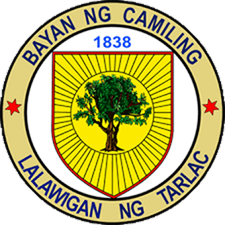A BRIEF HISTORY OF CAMILING
By Mark Jerome G. Domingo

Before it became what it is known today, Camiling was first referred to as Camiring, a tree abundant in the wilderness with leaves resembling mangoes. Later on, it underwent a linguistic shift from a strong “R” to a softer “L,” resulting in its transformation from Camiring to Camiling. Meanwhile, the friars regarded it as San Miguel in tribute to its patron saint. Subsequently, it evolved into San Miguel de Camiling until 1855, when the San Miguel part was dropped and the town became simply known as Camiling.
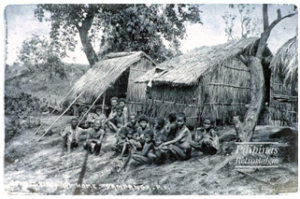 The first residents of this settlement were the Philippine Negritos commonly known as Aetas. However, when immigrants from the north arrived, their autonomy came to an end, compelling them to relocate to the inland areas. These immigrants, together with the Spanish conquistadors arriving in the area, initiated a period of significant change. Spanish missionaries introduced Christianity while the northern folks passed along their way of life.
The first residents of this settlement were the Philippine Negritos commonly known as Aetas. However, when immigrants from the north arrived, their autonomy came to an end, compelling them to relocate to the inland areas. These immigrants, together with the Spanish conquistadors arriving in the area, initiated a period of significant change. Spanish missionaries introduced Christianity while the northern folks passed along their way of life.
As the settlement made progress, Camiling became a District Commission from 1834 to 1837, established by Don Francisco Soriano, who served as both an influential barangay leader and the town’s first district commissioner.
Truth be told, there exist two narratives concerning the origins of Camiling. The first one says it was a visita of Bayambang and the other one says it was a sitio of Paniqui. In the Bayambang side of the story, the Camiling settlement was said to be part of the Pangasinan town and then eventually elevated to a status as a pueblo in 1838 upon petition of Fr. Fontcuberta to Don Vicente Galsim as the first gobernadoracillo.
The second narrative claims that Camiling originated from Paniqui, stating that in the early 18th century, the former was a sitio within the latter. A Spanish document unearthed in 1937 attested Camiling’s affiliation with Paniqui, indicating that its inhabitants paid tributes to Paniqui. In 1838, Camiling achieved autonomy, officially breaking away from its parent town and becoming an independent and distinguished town of its own.
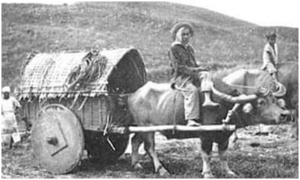 Camiling’s population rose over time, with Ilocanos being the vast majority. From 1815 until 1930, three waves of Ilocanos from the north migrated to Central Luzon. Many groups from Sinait, Cabugao, Sarat, and Paoay, joined by others, led by Vicente Galsim from Pangasinan set out for the well-known places in the south, hoping for permanent peace and more land to farm. They settled in Camiling, thus, there are such places in Camiling today as Casaratan, Cacabugaoan, and Capaoayan. The availability of land in Camiling spread to the Ilocos Region, attracting more immigrants. Groups from Vigan and Batac came and settled in the area which are now called Caviganan and Cabatacan. The Spanish influence is evident in Camiling’s landscape, highlighted by the construction of a grand church in 1863, with the help of the cabezas contributing their men for work. It was destroyed by an earthquake in 1880 but was rebuilt and improved. Over a century old, it was recognized as a historical site by the National Historical Commission in 1994. Unfortunately, it was gutted by fire in 1997, and its development as a historical landmark or attraction is still in process.
Camiling’s population rose over time, with Ilocanos being the vast majority. From 1815 until 1930, three waves of Ilocanos from the north migrated to Central Luzon. Many groups from Sinait, Cabugao, Sarat, and Paoay, joined by others, led by Vicente Galsim from Pangasinan set out for the well-known places in the south, hoping for permanent peace and more land to farm. They settled in Camiling, thus, there are such places in Camiling today as Casaratan, Cacabugaoan, and Capaoayan. The availability of land in Camiling spread to the Ilocos Region, attracting more immigrants. Groups from Vigan and Batac came and settled in the area which are now called Caviganan and Cabatacan. The Spanish influence is evident in Camiling’s landscape, highlighted by the construction of a grand church in 1863, with the help of the cabezas contributing their men for work. It was destroyed by an earthquake in 1880 but was rebuilt and improved. Over a century old, it was recognized as a historical site by the National Historical Commission in 1994. Unfortunately, it was gutted by fire in 1997, and its development as a historical landmark or attraction is still in process.
As time passed, Camiling evolved into a vibrant community, blending Spanish customs with local traditions. Today, remnants of its colonial history endure in its historic landmarks and cultural practices, serving as reminders of the town’s Spanish colonial heritage.
 After the Spanish Occupation, the American forces arrived in Camiling, bringing a new era of governance and development. They established schools and government institutions, promoting education and civic involvement. Despite the challenges of the new colonial masters, Camiling embraced American rule all together with the gains they attained. Today, the town’s people’s high regard for education can be seen in the long list of distinguished educators it produced which reflect the lasting impact of that era.
After the Spanish Occupation, the American forces arrived in Camiling, bringing a new era of governance and development. They established schools and government institutions, promoting education and civic involvement. Despite the challenges of the new colonial masters, Camiling embraced American rule all together with the gains they attained. Today, the town’s people’s high regard for education can be seen in the long list of distinguished educators it produced which reflect the lasting impact of that era.
As the Japanese forces swept through the Philippines in World War II, Camiling was not spared from the adversities of conflict. The once-vibrant and full-of-life streets of Camiling echoed with the sounds of panic.
 Residents fled to Bacsay and other remote barrios while Japanese soldiers marched and occupied the town. As panic waned, evacuees went back into town and accepted the reality of Japanese control. This was marked by challenges and unpredictability seeing the invaders showed cruelty and mercilessness to suspected guerillas and their sympathizers. They transformed the School Building No.1, now Camiling Central Elementary School, into a garrison serving as their headquarters.
Residents fled to Bacsay and other remote barrios while Japanese soldiers marched and occupied the town. As panic waned, evacuees went back into town and accepted the reality of Japanese control. This was marked by challenges and unpredictability seeing the invaders showed cruelty and mercilessness to suspected guerillas and their sympathizers. They transformed the School Building No.1, now Camiling Central Elementary School, into a garrison serving as their headquarters.
Nonetheless, the people of Camiling displayed courage in the face of difficulty. When liberation finally came, it brought with it a sense of relief and renewed hope for the future. The scars of war remained, but so too did the unwavering spirit of the Camileños, who emerged from the darkness of Japanese occupation with their heads held high, ready to rebuild and forge a brighter tomorrow.
 The liberation period brought in an epoch of development for the town. Schools and infrastructure were built. During these times, the Camiling Vocational Agricultural High School (formerly Tarlac College of Agriculture) now Tarlac Agricultural University, the Camiling Colleges and the Camiling Catholic School were established. Likewise, politics was also very active with local politicians battling for the top post of being the town’s local chief executive. The electoral and political battles of the town since then, up until now, have been considered a contest of rival political kingpins of the Cojuangco clans. Challenges were again experienced by Camileños, when, due to the increasing influence of communist- inspired mass movements, massive civil unrest in the country forced then President Marcos to declare Proclamation 1081 placing the whole country under Martial Law. Camiling faced a period of strict government control and restrictions. Every citizen was closely monitored, especially those aligned with the opposition, with curfews imposed and limited legal rights for everyone. While some residents supported these measures as necessary for instilling discipline and maintaining order, others lived in fear of random arrests and human rights abuses as they asserted their freedom and civil liberties. Despite the challenges, the people of Camiling find ways to adapt and survive.
The liberation period brought in an epoch of development for the town. Schools and infrastructure were built. During these times, the Camiling Vocational Agricultural High School (formerly Tarlac College of Agriculture) now Tarlac Agricultural University, the Camiling Colleges and the Camiling Catholic School were established. Likewise, politics was also very active with local politicians battling for the top post of being the town’s local chief executive. The electoral and political battles of the town since then, up until now, have been considered a contest of rival political kingpins of the Cojuangco clans. Challenges were again experienced by Camileños, when, due to the increasing influence of communist- inspired mass movements, massive civil unrest in the country forced then President Marcos to declare Proclamation 1081 placing the whole country under Martial Law. Camiling faced a period of strict government control and restrictions. Every citizen was closely monitored, especially those aligned with the opposition, with curfews imposed and limited legal rights for everyone. While some residents supported these measures as necessary for instilling discipline and maintaining order, others lived in fear of random arrests and human rights abuses as they asserted their freedom and civil liberties. Despite the challenges, the people of Camiling find ways to adapt and survive. 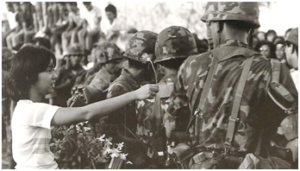 Years passed until the historic EDSA Revolution occurred and restored to the citizens the freedoms that were once curtailed by Martial Law. However, the lessons of martial law were etched in the hearts and minds of the people, serving as a reminder of the need to protect our democracy and freedom.
Years passed until the historic EDSA Revolution occurred and restored to the citizens the freedoms that were once curtailed by Martial Law. However, the lessons of martial law were etched in the hearts and minds of the people, serving as a reminder of the need to protect our democracy and freedom.
During the post-EDSA era, the continued progress of Camiling through the years was due to the sterling performance of governance by its elected leaders. Farm-to-market roads and poblacion streets were concreted, and numerous government structures and educational facilities were built. Furthermore, the local bureaucracy was enhanced and professionalized, social services particularly in health and welfare, and other services were institutionalized to meet the needs of its constituents.
Be that as it may, the march of Camiling into its present-day status as a developing first class municipality was not without difficulties.
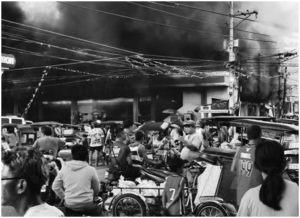
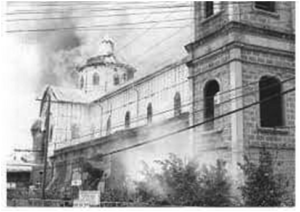 Natural calamities temporarily disrupted Camiling’s march to progress. The intense earthquake that shook the entire Luzon area in 1990 severely damaged the Camiling Catholic Church. In 1991, Mount Pinatubo erupted and affected residential and farm lands in the eastern barangays, which included Lasong, Florida, Caniag, Carael, and Sinilian areas. The Catholic Church was conflagrated in 1997, leaving the grand church in ruins. The typhoons of 2018 destroyed most of the municipality’s river dikes, resulting in massive flooding of barangays leaving millions in damages to infrastructure and crops. Moreover, last year, the Camiling Public Market’s dry goods and footwear section was gutted by fire.
Natural calamities temporarily disrupted Camiling’s march to progress. The intense earthquake that shook the entire Luzon area in 1990 severely damaged the Camiling Catholic Church. In 1991, Mount Pinatubo erupted and affected residential and farm lands in the eastern barangays, which included Lasong, Florida, Caniag, Carael, and Sinilian areas. The Catholic Church was conflagrated in 1997, leaving the grand church in ruins. The typhoons of 2018 destroyed most of the municipality’s river dikes, resulting in massive flooding of barangays leaving millions in damages to infrastructure and crops. Moreover, last year, the Camiling Public Market’s dry goods and footwear section was gutted by fire.
These temporary setbacks, however, did not diminish the determination of Camileños to adapt and overcome all of them. Throughout its history, the resiliency of the townspeople has been an indomitable force, unwavering in the face of adversity brought about by conflict and natural and man-made calamities.
The Municipality of Camiling, with its rich history and vibrant culture, stands as a testament to the spirit of its people. The Camileños, especially the youth, should study and appreciate its history. From its roots as a humble agricultural community to its present-day status as a thriving municipality, Camiling has continuously evolved, embracing progress while honoring its past. As we look towards the future, it is imperative to design its development with careful consideration for sustainability and inclusivity, ensuring that the heritage and values of Camiling are preserved for generations to come.
